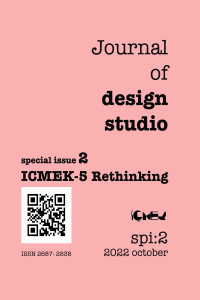Interview with Chat GPT to Define Architectural Design Studio Work: Possibilities, Conflicts and Limits
Interview with Chat GPT to Define Architectural Design Studio Work: Possibilities, Conflicts and Limits
Architectural design education, Defining studio, Artificial intelligence, Chat GPT Delphi technique,
___
- Biswas, S. (2023). Prospective Role of Chat GPT in the Military : According to ChatGPT. Qeios, CC-BY 4.0, February, 1–19.
- Biswas, S. S. (2023). Potential Use of Chat GPT in Global Warming. Annals of Biomedical Engineering. https://doi.org/10.1007/s10439-023-03171-8
- Caglar, N., & Uludag, Z. S. (2006). Architectural design education: Designing a library, public communication and information center in the manufacturing zone of Central Eskişehir Turkey, a case study. International Journal of Art and Design Education, 25(2), 231–240. https://doi.org/10.1111/j.1476-8070.2006.00487.x
- Caucheteux, C., Gramfort, A., & King, J. R. (2022). Deep language algorithms predict semantic comprehension from brain activity. Scientific Reports, 12(1), 1–10. https://doi.org/10.1038/s41598-022-20460-9
- ChatGPT. (2023). Retrieved 16 March 2023, from https://openai.com/blog/chatgpt
- Fink-Hafner, D., Dagen, T., Dousak, M., Novak, M., & Hafner-Fink, M. (2019). Delphi Method: Strengths and Weaknesses. Metodoloski Zvezki, 16(2), 1–19. https://doi.org/10.51936/FCFM6982
- Floridi, L., & Chiriatti, M. (2020). GPT-3: Its Nature, Scope, Limits, and Consequences. Minds and Machines, 30(4), 681–694. https://doi.org/10.1007/s11023-020-09548-1
- Ghosh, S., & Robson, K. F. (2015). Analyzing the Empire State Building Project from the Perspective of Lean Delivery System—A Descriptive Case Study. International Journal of Construction Education and Research, 11(4), 257–267. https://doi.org/10.1080/15578771.2015.1059395
- Hettithanthri, U., Hansen, P., & Munasinghe, H. (2022). Exploring the architectural design process assisted in conventional design studio: a systematic literature review. International Journal of Technology and Design Education, (0123456789). https://doi.org/10.1007/s10798-022-09792-9
- Landgrebe, J., & Smith, B. (2021). Making AI meaningful again. Synthese, 198(3), 2061–2081. https://doi.org/10.1007/s11229-019-02192-y
- Mcgee, R. W. (2023a). ANNIE CHAN: Three Short Stories Written with Chat GPT. https://doi.org/10.13140/RG.2.2.21169.66401
- Mcgee, R. W. (2023b). Who Were the 10 Best and 10 Worst U . S . Presidents? The Opinion of Chat GPT ( Artificial Intelligence ). https://doi.org/10.13140/RG.2.2.15304.19201 OpenAI. (2023). Retrieved 13 March 2023, from https://openai.com/
- Ozorhon, G., & Lekesiz, G. (2021). Re-considering the Architectural Design Studio after Pandemic: Tools, Problems, Potentials. Journal of Design Studio, (1), 19–36. https://doi.org/10.46474/jds.927181
- Park, E. J., & Lee, S. (2022). Creative Thinking in the Architecture Design Studio: Bibliometric Analysis and Literature Review. Buildings, 12(6). https://doi.org/10.3390/buildings12060828
- Rawes, P. (2007). Reflective Subjects in Kant and Architectural Design Education. The Journal of Aesthetic Education, 41(1), 74–89. https://doi.org/10.1353/JAE.2007.0006
- Renzi, A. B., & Freitas, S. (2015). The Delphi Method for Future Scenarios Construction. Procedia Manufacturing, 3, 5785–5791. https://doi.org/10.1016/j.promfg.2015.07.826
- Şahin, A. E. (2001). Delphi Technique and Its Uses in Educational Research. Hacettepe Üniversitesi Eğitim Fakültesi Dergisi, 20, 2015–2220.
- Sobieszek, A., & Price, T. (2022). Playing Games with Ais: The Limits of GPT-3 and Similar Large Language Models. Minds and Machines, 32(2), 341–364. https://doi.org/10.1007/s11023-022-09602-0
- Tafahomi, R. (2022). Insight into Research Dilemma in Design Studios and Relationships with the Architecture Curriculum. Journal of Design Studio, 4(1), 93–112. https://doi.org/10.46474/jds.1102633
- Turoff, M., & Linstone, H. A. (2002). The Delphi method-Tecniques and Applications. https://doi.org/10.1007/s00256-011-1145-z
- Tuztasi, U., & Koc, P. (2022). Vertical Design Studio in Architectural Education: A Summer Practice on Corner Parcel. Journal of Design Studio, 4(2), 163–177. https://doi.org/10.46474/jds.1180916
- Utaberta, N., Hassanpour, B., Bahar, M. A., & Che Ani, A. I. (2013). A Comprehensive Learning of Architecture Education: Understanding Critique Session as Learning Process and Criteria-based Assessment in the Architecture Design Studio. Procedia - Social and Behavioral Sciences, 102, 21–32. https://doi.org/10.1016/j.sbspro.2013.10.709
- Yang, X., Li, Y., Zhang, X., Chen, H., & Cheng, W. (2023). Exploring the Limits of ChatGPT for Query or Aspect-based Text Summarization. Arxiv, February. https://doi.org/https://doi.org/10.48550/arXiv.2302.08081
- Yurtkuran, S., Kırlı, G., & Taneli, Y. (2013). An Innovative Approach in Architectural Education: Designing a Utopia. Procedia - Social and Behavioral Sciences, 89, 821–829. https://doi.org/10.1016/j.sbspro.2013.08.939
- Yurtsever, B., & Polatoğlu, Ç. (2020). Mimari Tasarım Eğitiminde ‘Aktif Stüdyo’ Deneyimleri. MEGARON / Yıldız Technical University, Faculty of Architecture E-Journal, 15(3), 412–429. https://doi.org/10.14744/megaron.2020.57614
- Yayın Aralığı: Yılda 2 Sayı
- Başlangıç: 2019
- Yayıncı: Orhan HACIHASANOĞLU
Design Studio Insights: Anthropometric Considerations for Ergonomic Design of Wet Services
Plasticity Imaginaries as Sustainable Design Pedagogy
Tatyana KUSUMO, Apriani Kurnia SARASHAYU
An Exploration of Conceptual Prototype of an Artistic Handcraft Wallet (AHW) Design
Alternative Scale(ing) Practices in Architectural Design Studio
A. Derin İNAN, Başak UÇAR, Onur YÜNCÜ
Serpil Fatma ERTÜRK, Setenay UÇAR
Dreaming for Sivas Selections from Architectural Studios, 2014-2021
Tracing Hegel’s Philosophy and Thoughts in Educational Styles of Architecture Design Studios
